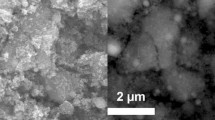Abstract
In this study, highly pure magnetite nanoparticle dispersed in water and an organic solvent (n-hexane) and its powder form were prepared in laboratory scale by the fractional precipitation using ammonium hydroxide and microwave heating in the presence of linoleic acid as capping agent. In order to overcome the oxidation of Fe2+ during magnetite formation ferrous ammonium sulfate, sodium azide, and fractional precipitation technique were used. The Fe3O4 products were investigated by XRD, LLS, EDX, TEM, viscosity measurements, and chemical analysis. The effects of seven main factors on the average diameter of magnetite particles were studied by a screening design. The analysis of the samples showed that this new modified method is able to produce pure magnetite particles in the range of 1–15 nm. The most important factors on the particle size reduction of magnetite were found to be the capping agent used and the pH of solution at the end of precipitation process. Data analysis was performed using Qualitek-4 and Minitab softwares.







Similar content being viewed by others
References
Albornoz C, Jacobo SE (2006) Preparation of a biocompatible magnetic film from an aqueous ferrofluid. J Magn Magn Mater 305:12–15
Büscher K, Helm CA, Gross C, Glöckl G, Romanus E, Weitschies W (2004) Nanoparticle composition of a ferrofluid and its effects on the magnetic properties. Langmuir 20:2435–2444
Butter K, Philipse AP, Vroege GJ (2002) Synthesis and properties of iron ferrofluids. J Magn Magn Mater 252:1–3
Dailey JP, Phillips JP, Li C, Riffle JS (1999) Synthesis of silicone magnetic fluid for use in eye surgery. J Magn Magn Mater 194:140–148
Enzel P, Adelman NB et al (1999) Preparation and properties of an aqueous ferrofluid. J Chem Educ 76:943
Hargiss LG (1998) Analytical chemistry. Prentice-Hall, Englewood Cliffs, p 71
Hong RY, Pan TT, Li HZ (2006) Microwave synthesis of magnetic Fe3O4 nanoparticles used as a precursor of nanocomposites and ferrofluids. J Magn Magn Mater 303:60–68
Horng HE, Yang SY, Hong CY, Yang HC, Liao SH, Liu CM, Wu CC (2006) Magnetic nano-particles and their applications in immunoassays. J Korean Phys Soc 48:999
Ilona NK, Dorottya CN, Mihaly C (2009) Size and shape control of precipitated magnetite nanoparticles. Eur J Mineral 21:293–302
Kholmetskii AL, Vorobyova SA et al (2005) A novel route for the preparation of magnetic fluids. Mater Lett 59:1993–1996
Maity D, Agrawal DC (2007) Synthesis of iron oxide nanoparticles under oxidizing environment and their stabilization in aqueous and non-aqueous media. J Magn Magn Mater 308:46–55
Montgomery DC (2001) Design and analysis of experiments. Wiley, New York
Mornet S, Portier J, Duguet E (2005) A method for synthesis and functionalization of ultrasmall superparamagnetic covalent carriers based on maghemite and dextran. J Magn Magn Mater 293:127–134
Mozger TG (2002) The rheology handbook. Vincentz, Hannover
Müller R, Hiergeist R, Steinmetz H, Ayoub N, Fujisaki M, Schüppel W (1999) Barium hexaferrite ferrofluids: preparation and physical properties. J Magn Magn Mater 201:34–37
Odenbach S, Völker T (2005) Thermal convection in a ferrofluid supported by thermodiffusion. J Magn Magn Mater 289:122–125
Skoog DA, West DA, Holler FJ (1996) Fundamentals of analytical chemistry. Sunders, Philadelphia, p 83
Uhlmann E, Spur G, Bayat N, Patzwald R (2002) Application of magnetic fluids in tribotechnical systems. J Magn Magn Mater 252:336–340
Vogel AI (1987) Textbook of quantitative inorganic analysis. Longman, London
Young SK, Young HK (2003) Application of ferro-cobalt magnetic fluid for oil sealing. J Magn Magn Mater 267:105–110
Yu LQ, Zheng LJ, Yang JX (2000) Study of preparation and properties on magnetization and stability for ferromagnetic fluids. Mater Chem Phys 66:6–9
Author information
Authors and Affiliations
Corresponding author
Rights and permissions
About this article
Cite this article
Edrissi, M., Norouzbeigi, R. Microwave-assisted fractional precipitation of magnetite nanoparticles using designed experiments. J Nanopart Res 12, 1231–1238 (2010). https://doi.org/10.1007/s11051-009-9814-8
Received:
Accepted:
Published:
Issue Date:
DOI: https://doi.org/10.1007/s11051-009-9814-8




